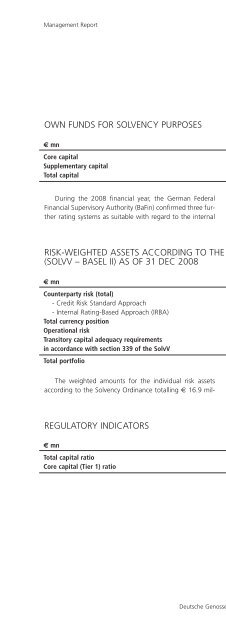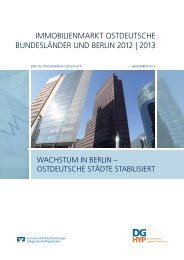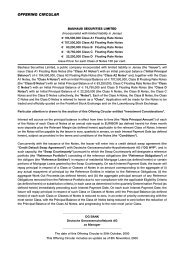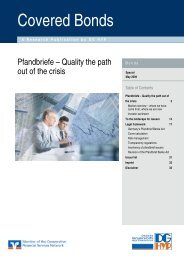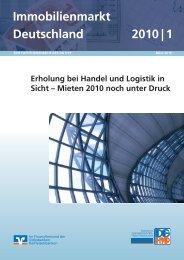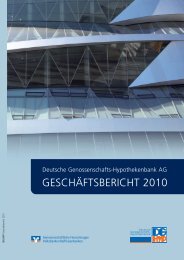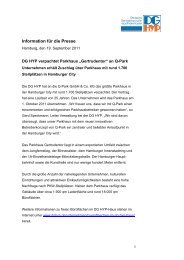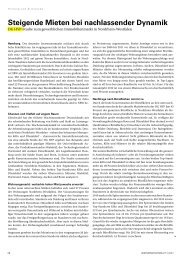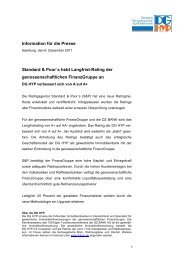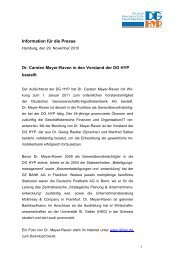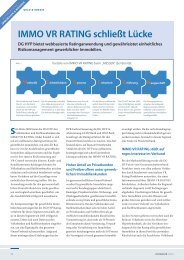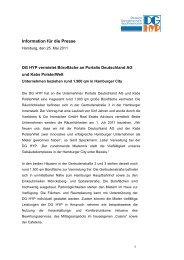ANNUAL REPORT 2008 - DG Hyp
ANNUAL REPORT 2008 - DG Hyp
ANNUAL REPORT 2008 - DG Hyp
Create successful ePaper yourself
Turn your PDF publications into a flip-book with our unique Google optimized e-Paper software.
Intangible and tangible fixed assets<br />
Tangible fixed assets are carried at cost less regular<br />
depreciation, where applicable. In the year under review, a<br />
write-down to the lower going concern value under German<br />
tax laws (Teilwert) was recognised for the building in<br />
Rosenstrasse 2, Hamburg. Movable tangible fixed assets<br />
are predominantly depreciated on a straight-line basis,<br />
using the maximum rates permissible under tax laws, or<br />
based on the declining-balance method with a subsequent<br />
transfer to straight-line depreciation. Low-value assets are<br />
written off in full during their year of purchase. Standard<br />
software is reported under intangible assets, as prescribed<br />
by accounting standard HFA 11 issued by the Main Committee<br />
of the IDW (IDW RS HFA 11). As a result of the<br />
change of the business model, write-downs in the amount<br />
of € 6.5 million had to be recognised for a securitisation<br />
software and a capitalised expected economic benefit due<br />
to the resulting impairment.<br />
Liabilities<br />
Liabilities are shown on the balance sheet at the<br />
amount due for repayment. The difference between the<br />
nominal value and the initial carrying amount of liabilities is<br />
recognised under deferred items and amortised over the<br />
term of the transaction.<br />
Liabilities classified as structured products (as defined in<br />
Accounting Practice Statement BFA 1.003 issued by the<br />
Banking Committee of the IdW) are accounted for as uniform<br />
liabilities as they only contain embedded interest rate<br />
derivatives. Such liabilities are grouped with corresponding<br />
hedge transactions, to establish hedging relationships.<br />
The partial profits to be paid for silent partnership contributions<br />
are carried in their full amount.<br />
Provisions<br />
Contingent liabilities are covered by provisions<br />
equalling the anticipated amount of the liability, on the<br />
basis of prudent business judgement. Provisions for pensions<br />
are determined using the cost (“Teilwert”) method in<br />
accordance with actuarial principles, using the actuarial<br />
tables 2005 G by Dr. Klaus Heubeck. The imputed rate used<br />
for discounting was 4.5 per cent.<br />
54 Deutsche Genossenschafts-<strong>Hyp</strong>othekenbank AG | Annual Report <strong>2008</strong><br />
Notes to the Financial Statements<br />
Derivative financial instruments<br />
Financial derivatives are accounted for separately in<br />
auxiliary ledgers. These instruments are generally used to<br />
hedge the interest rate and currency risk exposure of onbalance<br />
sheet transactions. Current interest payments are<br />
amortised and recorded in net interest income.<br />
Income from the disposal (close-out) of interest ratebased<br />
derivative financial instruments is generally recognised<br />
in interest income. Where interest rate swaps are<br />
grouped with securities, to establish hedging relationships<br />
(asset swaps), income realised upon closing out swaps are<br />
recognised in line with the recognition of income of the<br />
underlying transaction, in the net result on financial assets,<br />
or in the net risk provisioning balance, respectively.<br />
Premiums paid or received for credit default swaps are<br />
amortised in commission income over the terms of the<br />
transactions.<br />
Premium payments for swaptions entered into as a<br />
hedge against the impact of statutory loan termination<br />
rights pursuant to section 489 of the German Civil Code<br />
(Bürgerliches Gesetzbuch - „BGB“) are allocated to the<br />
investment portfolio and carried at cost.<br />
(3) Currency translation<br />
Assets and liabilities from foreign exchange transactions<br />
are translated in line with section 340h of the HGB and<br />
Statement BFA 3/1995 issued by the IdW. Book receivables,<br />
securities, liabilities and unsettled spot transactions are<br />
generally translated using the ECB reference rate prevailing<br />
on the balance sheet date. Income and expenses from currency<br />
translation are recognised in the income statement in<br />
accordance with section 340h of the HGB. Income and<br />
expenses from foreign exchange forwards, which were<br />
entered into exclusively for the purpose of hedging interestbearing<br />
balance sheet items, are recognised in interest<br />
income.


